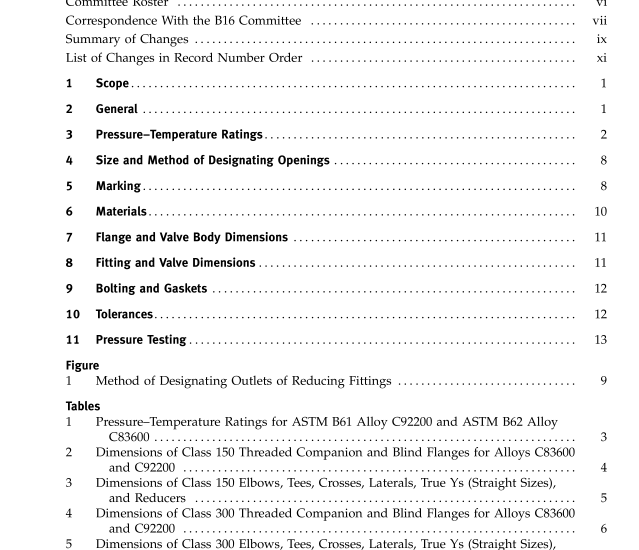ASME B16.24:2016 pdf download Cast Copper Alloy Pipe Flanges, Flanged Fittings, and Valves Classes 150, 300, 600, 900, 1500, and 2500
3 PRESSURE–TEMPERATURE RATINGS
3.1 General (a) For flanges and flanged fittings, the tabulated pressure–temperature ratings of Table 1 (Table I-1) shall apply for the materials listed in paras. 6.2.1 and 6.2.2, provided that the dimensional requirements of Tables 2 through 5 (Tables I-2 through I-5) are met. (b) Requirements for valves made from ASTM B61 alloy C92200 and ASTM B62 alloy C83600 are covered by MSS SP-80. (c) For ASTM B148 alloys C95200 and C95400 flanges, and flanged and threaded end valves only, the tabulated pressure–temperature ratings of Table 6 (Table I-6) and Table 7 (Table I-7) shall apply, provided that the dimen- sional requirements of ASME B16.5 are met for flanges and applicable dimensional requirements of ASME B16.5 or ASME B16.47 are met for flanged valves. Threaded end valves shall have taperpipe threads (NPT) meeting the dimensional requirements ofASME B1.20.1.
3.2 Flanged Joints A flanged joint is composed of separate and indepen- dent, although interrelated, components. The flanges, the gasket, and the bolting are assembled by another 2 influence —the assembler. Proper controls must be exer- cised in the selection and application for all these ele- ments to attain a joint that has acceptable leak tightness. Special techniques (e.g., controlled bolt tightening) are described in ASME PCC-1.
3.3 Pressure–Temperature Ratings of Flanged Joints Pressure–temperature ratings in this Standard apply to flanged joints that conform to the requirements on bolting in paras. 6.5 and 9.1, on gaskets in paras. 6.6 and 9.2, and to flanged joints that are made up in accor- dance with good practice for alignment and assembly. Use of the pressure–temperature ratings for flanged joints not conforming to these requirements is the sole responsibility of the user. Requirements for alignment and assembly of joints and consideration of leakage due to forces and moments developed in the connected pip- ing or equipment are not covered in this Standard. If the two flanges in a flanged joint do not have the same pressure–temperature ratings, the pressure– temperature rating of the joint at any temperature is the lower of the two flange pressure–temperature ratings at that temperature.
3.4 Rating Temperature The temperatureshownfora correspondingpressure– temperature rating is the temperature of the pressure- containing shell of the flange, flanged fitting, or valve. In general, this temperature is the same as that of the contained fluid. Use of a pressure–temperature rating corresponding to a temperature other than that of the contained fluid is the responsibility of the user, subject to the applicable code orregulation. For anytemperature below −29°C (−20°F), the pressure–temperature rating shall be no greater than the pressure–temperature rating for −29°C (−20°F). See para. 6.5.1 for temperature limita- tions on use of ASTM A307 bolting.
3.5 Low-Temperature Service It is the responsibility of the user to verify that all of the component materials (i.e., flange, bolting, and gas- ket, etc.) selected are acceptable for use in temperature applications below −29°C (−20°F). Whenpermitted, cop- per alloy flanges, flanged fittings, and valves manufac- tured in accordance with this Standard, assembled with suitable bolting and gaskets, and subject to the applica- ble code or regulations shall not be used at temperatures below −198°C (−325°F) except for ASTM B148 alloy C95200, which can be used to −269°C (−452°F). For guid- ance on low-temperature service, refer to ASME B31T.
3.6 System Hydrostatic Test Flanged joints, flanged fittings, and flanged or threaded end valves may be subjected to system hydro- static tests at pressures not to exceed 1.5 times the tabu- lated pressure at 38°C (100°F). System testing at higher
